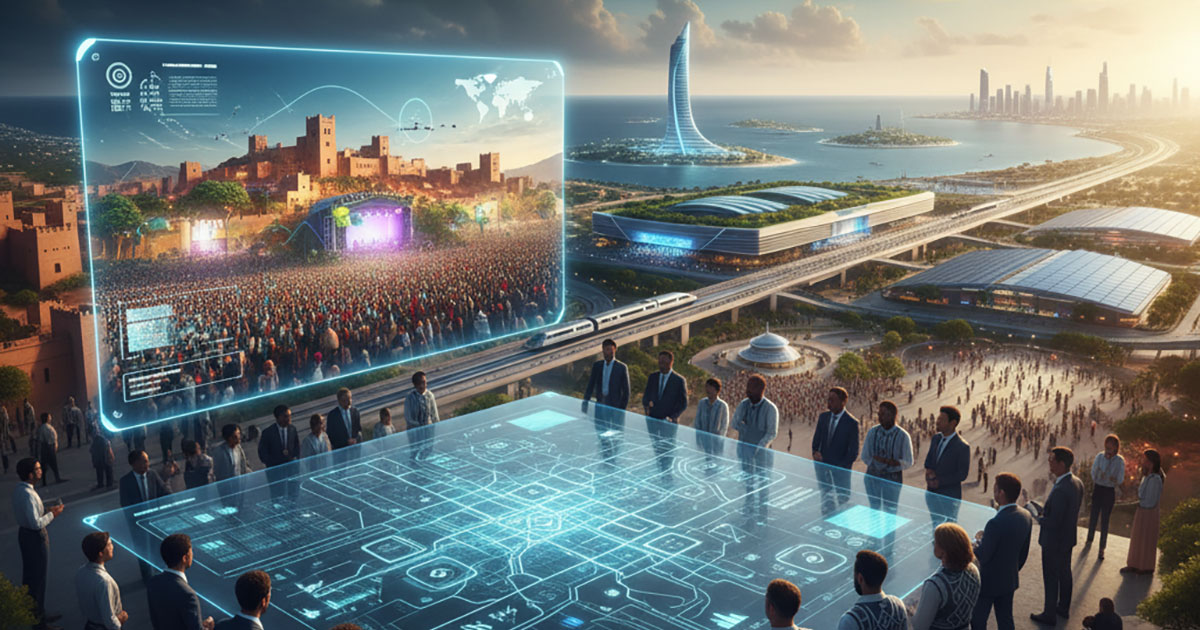By Morocco-based interpreters for professional conference interpreters
The year 2026 is poised to be more than just another date on the calendar for Morocco’s events industry; it is the tipping point. For event organizers, 2026 represents the crest of a massive wave of national investment, a critical inflection point between the aggressive targets of the 2023-2026 Tourism Roadmap and the inevitable global spotlight of the 2030 FIFA World Cup.
Morocco’s economy is forecasted to post robust GDP growth of 3.8% to 4.6%, driven largely by a buoyant tourism sector targeting an astonishing 17.5 million visitors by the end of 2026. This surge in economic activity, coupled with a national infrastructure overhaul, demands a complete recalibration of strategy for every professional in the Meetings, Incentives, Conventions, and Exhibitions (MICE) sector. The old ways of operating are giving way to a new paradigm of efficiency, scale, and sustainability.
Here are the eight most crucial developments that will define success for event organizers operating in Morocco in 2026.
1. The Global MICE Stress Test: Major International Events
The beginning of 2026 will immediately put Morocco’s event logistics to the ultimate test: the hosting of major international tournaments like the CAF Africa Cup of Nations finals in January. This event, concentrated in key host cities like Rabat and Casablanca, will serve as a high-volume, high-stakes rehearsal for the World Cup.
For event organizers, this means two things:
- Market Saturation: Availability of premium venues, high-end hotel inventory, and skilled technical labor will be severely restricted during major sports events. Smart organizers will need to lock in dates, venues, and specialized personnel well in advance, focusing on the shoulder seasons or positioning events in secondary MICE cities.
- Accelerated Professionalization: The visibility and scrutiny from these global sporting events will accelerate the standardization of service quality, security protocols, and visitor experience across the country. Organizers who have already implemented international best practices will be better positioned to win high-tier corporate and association events.
2. The Infrastructure Windfall: A Leap in Accessibility and Scale
The massive MAD 380 billion public investment plan, largely fast-tracked by the 2030 World Cup bid, will start paying tangible dividends by 2026. This is fundamentally changing the calculus of MICE logistics.
Key infrastructure milestones impacting organizers:
- Airports at Scale: Expansion projects, including a new airport in Casablanca and upgrades in Rabat-Salé and Fez, are underway to push national passenger capacity toward 80 million by 2030. For event organizers, this translates to significantly better air connectivity, increased flight routes, and reduced logistical bottlenecks for international attendees.
- High-Speed Rail Connectivity: The extension of the High-Speed Rail (TGV) network, particularly the Kenitra to Marrakech connection, will drastically cut travel times between major economic and tourist hubs. This makes multi-city itineraries and the “hub-and-spoke” event model—holding satellite meetings around a main convention—vastly more feasible and attractive.
The challenge here is to adapt quickly to these new logistical possibilities, designing event schedules that capitalize on seamless inter-city travel.
3. Sustainability as a Non-Negotiable Mandate
Sustainability is moving from a ‘nice-to-have’ to a core contractual requirement. Morocco’s strong national commitment to green energy—with renewables already accounting for 45% of the electricity mix—is setting a national precedent for the events sector.
The event industry must align with two major shifts:
- Green Venue Sourcing: Organizers will prioritize venues powered by the nation’s robust solar and wind energy networks. Expect RFPs to increasingly demand detailed reporting on energy consumption, waste management, and water usage, especially given Morocco’s focus on water scarcity management.
- The World Cup Green Commitment: Morocco’s pledge to make the 2030 tournament a model for environmental sustainability means all ancillary business, including MICE, will be expected to follow suit. Implementing comprehensive waste reduction strategies, choosing local suppliers, and transparent carbon offsetting will become standard practice by 2026.
4. The Rise of the Smart MICE City
The official push to establish key urban centers like Casablanca and Marrakech as “Smart Cities” by 2026 means the integration of digital technology into urban management. For organizers, this offers powerful new tools:
- Data-Driven Events: Smart City infrastructure can feed organizers with real-time data on urban traffic, public transport availability, and crowd movements, enabling dynamic adjustments to logistics, security planning, and shuttle services.
- Digital-First Engagement: Attendees will expect seamless connectivity, digital wayfinding, and efficient integrated event apps. The organizational shift towards utilizing digitalization for efficient city services will raise the bar for the technological sophistication of the events themselves.
5. Product Diversification Beyond the Pillars
The 2023-2026 Tourism Roadmap allocates a dedicated budget to enhance the tourism product, identifying nine thematic sectors and actively promoting diversification beyond the traditional pillars of Marrakech and Casablanca.
- Emerging MICE Destinations: Cities like Agadir and the development of the Dakhla Atlantic Port will position Morocco’s South as a viable, specialized destination for niche events like adventure tourism conferences, eco-focused retreats, and blue economy summits. Organizers can offer clients new, distinctive experiences far from the crowded main hubs.
- Thematic Specialization: Events focused on Morocco’s core strengths—renewable energy (green hydrogen), automotive manufacturing, and the African-European gateway—will see exponential growth, attracting high-value international delegates.
6. The Digitalization of Event Logistics
The proposed integration of Blockchain in the Customs Clearance Process as part of the 2026 draft budget signals a broader governmental commitment to digitalizing trade and logistics.
While technical, this has a profound operational impact on event organizers: streamlined import/export of high-value event equipment (exhibit stands, technical gear, specialized IT), potentially reducing wait times and the risk of costly delays. This administrative efficiency boosts Morocco’s competitive edge against other regional MICE destinations.
7. Upskilling the Moroccan Talent Pool
The push to create 200,000 new direct and indirect jobs in the tourism sector by 2026, as targeted by the roadmap, is supported by initiatives to enhance human capital and vocational training.
For organizers, this means:
- Higher Service Quality: Access to a growing pool of highly trained, multilingual professionals ensures that service quality meets international standards, a critical component for association and incentive groups.
- Reduced Reliance on Expatriates: Greater local expertise lowers operational costs and deepens the cultural authenticity of the event experience. Investing in and partnering with local, certified event management talent will become a strategic differentiator.
8. Mastering the ‘Phygital’ Experience
With accelerated digitalization and improved physical connectivity, 2026 solidifies the need for the ‘Phygital’ event model—a seamless blend of the physical and digital.
Morocco’s unique selling proposition (USP) is its unparalleled cultural and sensory experience. The challenge for event organizers is to integrate the digital tools that provide global reach and data insights without sacrificing the rich, tangible, and authentic Moroccan experience that attendees travel for. Success will lie in using technology to enhance the physical interaction, not replace it.
The Path Forward: Scale, Green, and Connect
For the Moroccan event organizer, 2026 is the crucial year to move beyond recovery and into rapid scaling. The nation is providing the budget, the infrastructure, and the global visibility; the organizer’s job is to deliver on the promise. The successful event organizer of 2026 will be the one who embraces scalability, embeds sustainability into their DNA, and masterfully uses the new physical and digital connectivity to create world-class, authentically Moroccan experiences. The countdown to 2030 has truly begun.

